- Home
- About
- Map
- Trips
- Bringing Boat West
- Migration West
- Solo Motorcycle Ride
- Final Family XC Trip
- Colorado Rockies
- Graduates' XC Trip
- Yosemite & Nevada
- Colorado & Utah
- Best of Utah
- Southern Loop
- Pacific Northwest
- Northern Loop
- Los Angeles to NYC
- East Coast Trips
- 1 Week in Quebec
- Southeast Coast
- NH Backpacking
- Martha's Vineyard
- Canadian Maritimes
- Ocracoke Island
- Edisto Island
- First Landing '02
- Hunting Island '02
- Stowe in Winter
- Hunting Island '01
- Lake Placid
- Chesapeake
- Provincetown
- Hunting Island '00
- Acadia in Winter
- Boston Suburbs
- Niagara Falls
- First Landing '99
- Cape Hatteras
- West Coast Trips
- Maui
- Mojave 4WD Course
- Colorado River Rafting
- Bishop & Death Valley
- Kauai
- Yosemite Fall
- Utah Off-Road
- Lost Coast
- Yosemite Valley
- Arizona and New Mexico
- Pescadero & Capitola
- Bishop & Death Valley
- San Diego, Anza Borrego, Joshua Tree
- Carmel
- Death Valley in Fall
- Yosemite in the Fall
- Pacific Northwest
- Utah Off-Roading
- Southern CA Deserts
- Yosemite & Covid
- Lake Powell Covid
- Eastern Sierra & Covid
- Bishop & Death Valley
- Central & SE Oregon
- Mojave Road
- Eastern Sierra
- Trinity Alps
- Tuolumne Meadows
- Lake Powell Boating
- Eastern Sierra
- Yosemite Winter
- Hawaii
- 4WD Eastern Sierra
- 4WD Death Valley +
- Southern CA Deserts
- Christmas in Tahoe
- Yosemite & Pinnacles
- Totality
- Yosemite & Sierra
- Yosemite Christmas
- Yosemite, San Diego
- Yosemite & North CA
- Seattle to Sierra
- Southwest Deserts
- Yosemite & Sierra
- Pacific Northwest
- Yosemite & South CA
- Pacific Northwest
- Northern California
- Southern Alaska
- Vancouver Island
- International Trips
- Index
- Tips
- Books
- Photos/Videos
- Search
- Contact
Salt Point State Park, CA
Tuesday, July 25, 2023 - 9:00pm by Lolo
60 miles and 1.5 hours from our last stop
Travelogue
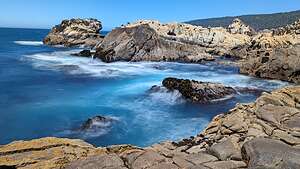 Salt Point State ParkAs I mentioned in the Trip Overview, we have been fortunate enough to have seen much of the incredibly beautiful California coast, but our all-time favorite spot of all is Salt Point State Park, just 100 miles north of San Francisco.
Salt Point State ParkAs I mentioned in the Trip Overview, we have been fortunate enough to have seen much of the incredibly beautiful California coast, but our all-time favorite spot of all is Salt Point State Park, just 100 miles north of San Francisco.
The park covers 6,000 acres along the Northern California coast, with 6 miles of rough rocky coastline. And what a unique coastline it is!!
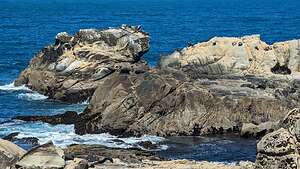 Salt Point State ParkIt’s only an hour and a half drive from our home, but most of that drive is extremely winding and twisty, so it was good to take a break and stretch our legs.
Salt Point State ParkIt’s only an hour and a half drive from our home, but most of that drive is extremely winding and twisty, so it was good to take a break and stretch our legs.
Our favorite place to hike in Salt Point State Park is the 3-mile out and back trail from Gerstle Cove to Stump Beach. It’s probably one of the most unique and dramatic sections of the California coast, and that is saying a lot.
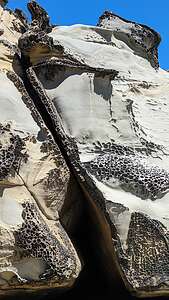 Tafoni Salt Point State ParkWhat this beach is most well known for, and the reason we love to come here over and over again, is that it is one of the few places on the coast that has tafoni - uniquely textured sandstone with holes and honeycomb-like structures - sort of like Swiss cheese. The other place we have seen these intriguing rocks is Pescadero State Beach, about a half hour south of Half Moon Bay.
Tafoni Salt Point State ParkWhat this beach is most well known for, and the reason we love to come here over and over again, is that it is one of the few places on the coast that has tafoni - uniquely textured sandstone with holes and honeycomb-like structures - sort of like Swiss cheese. The other place we have seen these intriguing rocks is Pescadero State Beach, about a half hour south of Half Moon Bay.
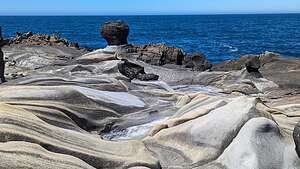 Salt Point State ParkThere are several theories as to how these amazing rocks were formed, but the most common one is salt weathering. According to this theory, saltwater collects on the surface of the permeable sandstone from the nearby waves and mist.
Salt Point State ParkThere are several theories as to how these amazing rocks were formed, but the most common one is salt weathering. According to this theory, saltwater collects on the surface of the permeable sandstone from the nearby waves and mist.
As the saltwater evaporates, the salt it leaves behind works its way into the rock pores, where it crystallizes and pushes the pores open further. Wind, rain, and tidal water also contribute to their weathering.
Many of the rocks have weird shapes that we have come to recognize each time we visit. Many of them look like heads standing on pedestals. There is even a set of eyes set in the stone. Oh, and of course there is our old friend, the pig.
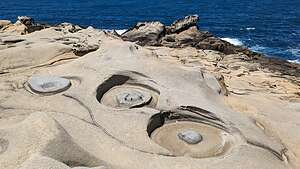 The Eyes of Salt PointAt one point, I came across a pile of the park’s namesake “salt" in a depression of rock. The name of this park comes from these salt crystals that have formed over millions of years in the crevices and nooks and crannies of this rocky coastline.
The Eyes of Salt PointAt one point, I came across a pile of the park’s namesake “salt" in a depression of rock. The name of this park comes from these salt crystals that have formed over millions of years in the crevices and nooks and crannies of this rocky coastline.
The native Kashaya Pomo collected salt from this area for many years. They used abalone chisels to scrape the salt off the rocks.
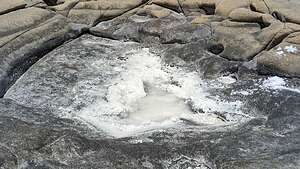 "Salt" Point State ParkSalt was not the only resource they found at Salt Point. Shellfish, including abalone, were gathered along the coastline, and seaweed was collected and dried.
"Salt" Point State ParkSalt was not the only resource they found at Salt Point. Shellfish, including abalone, were gathered along the coastline, and seaweed was collected and dried.
The Eyes of Salt PointAn estimated 1,500 Kashia people inhabited this area along the Sonoma Coast until the arrival of Russian American Company settlers in the 19th century. The Russians did not really make use of the scarce quantity of salt found along the shoreline, but purchased it from the Spanish instead. However, salt remains an important enough part of its history to include it in its name.
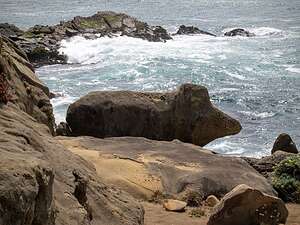 The "Piggy"; of Salt PointIn the 1850s a San Francisco company quarried the sandstone from this park to create the streets and buildings in the fast-growing city of San Francisco.
The "Piggy"; of Salt PointIn the 1850s a San Francisco company quarried the sandstone from this park to create the streets and buildings in the fast-growing city of San Francisco.
Today, Salt Point’s major resource is its stunning beauty, which we very much enjoyed along our stroll along its coastline.
It would have been nice to spend the night here because the rocky formations light up in beautiful colors during the golden hour, but we had reservations to spend the night at St. Orres. More on that later.
We will have to come back soon and camp at Gerstle Cove so we can enjoy this beautiful place in both evening and morning light.
- 1 of 4
- next ›
